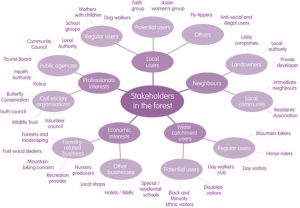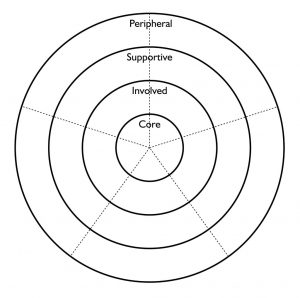




Stakeholder mapping
Stakeholder mapping is the collaborative process of identifying a list of key people within your community (and beyond if necessary) and organising them into groups. The below information will help you identify these key people, what impact they’re likely to have on your project, and some suggestions of how to engage with them.
A stakeholder is any person or organisation that has an interest or influence in what you want to achieve. Once you have identified your purpose or outcome, it’s useful to think about who might be useful to engage with to support to support your community-led change efforts.
So let’s get started
There are many different ways that stakeholder mapping can be approached. They generally involve a mix of:
Read more…
Identifying: listing the relevant groups, organisations and people who will have an interest in or connection to the outcome or purpose you are interested in.
Analysing: going deeper to understand stakeholder perspectives and interests. This can be done informally (e.g. through brainstorming and conversations) or more formally (e.g. through surveying, structured meetings/engagement processes).
Mapping: visualising how particular stakeholder relationships might link and connect with the objectives and outcomes you are seeking. For example, the Forest Stakeholder Map below (from an earlier version of the UK Forestry Commission website) visually links different layers of interests and connection to the forest.
Prioritising: ranking stakeholder connections and interests to help work out who to engage or involve and how or how deeply.
It’s useful to intentionally think about who to work with in terms of their:
- Stake in the issue/vision/project
- Possible influence on the outcome
- Willingness to be involved
- Potential contribution (funds, information, land, mana, networks)
Levels of stakeholder participation and collaboration
Stakeholders can collaborate with you at varying levels. Some will want to be more involved than others.
Read more…
An example of a stakeholder mapping wheel.
The Tamarack Community Engagement Wheel can also be adapted for stakeholder scanning and prioritising in terms of the who factors above.
The Working Together Continuum explains more about the different levels of collaboration between you and your stakeholders or partners.
The Different Levels of Collaboration
Core to Success: This initiative won’t happen without them. Their active participation in solution-making and decision-taking is critical. (Partnership/integration/strong collaboration)
Involved: They have a direct stake in the outcome and should be linked to and contributing to what’s happening. (Collaboration)
Supportive: They care about the vision and need to stay lightly engaged, receive updates, etc. They can help if called on. (Co-operation)
Peripheral: They receive information and know what’s happening, but don’t need to be directly involved. (Communication)
A template follows to help you brainstorm and prioritise key stakeholders to engage and involve follows next:
A final check
- Are these stakeholders reflected in your stakeholder scan? How?
- Who else might have a stake in the outcomes but not have influence, money or an initial desire to be involved?
- What else can you do to engage with and involve them?



